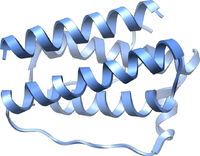
Photo from wikipedia
Leptin, a hormone primarily produced by adipocytes, contributes to the regulation of bone health by modulating bone density, growth and adiposity. Upon leptin binding, multiple sites of the long form… Click to show full abstract
Leptin, a hormone primarily produced by adipocytes, contributes to the regulation of bone health by modulating bone density, growth and adiposity. Upon leptin binding, multiple sites of the long form of the leptin receptor (LepRb) are phosphorylated to trigger activation of downstream signaling pathways. To address the role of LepRb‐signaling pathways in bone health, we compared the effects of three LepRb mutations on bone density, adiposity, and growth in male and female mice. The ∆65 mutation, which lacks the known tyrosine phosphorylation sites, caused obesity and the most dramatic bone phenotype marked by excessive bone adiposity, osteoporosis, and decreased growth, consistent with the phenotype of db/db and ob/ob mice that fully lack leptin receptor signaling. Mutation of LepRb Tyr 1138, which results in an inability to recruit and phosphorylate signal transducer and activator of transcription 3, also caused obesity, but bone loss and adiposity were more dominant in male mice and no growth defect was observed. In contrast, mutation of LepRb Tyr 985, which blocks SHP2/SOCS3 recruitment to LepRb and contributes to leptin hypersensitivity, promoted increased femur bone density only in male mice, while marrow adiposity and bone growth were not affected. Additional analyses of vertebral trabecular bone volume indicate that only the Tyr 1138 mutant mice exhibit bone loss in vertebrae. Together, our findings suggest that the phosphorylation status of specific sites of the LepRb contribute to the sex‐ and location‐dependent bone responses to leptin. Unraveling the mechanisms by which leptin responses are sex‐ and location‐dependent can contribute to the development of uniquely targeted osteoporosis therapies.
Journal Title: Journal of Cellular Biochemistry
Year Published: 2019
Link to full text (if available)
Share on Social Media: Sign Up to like & get
recommendations!